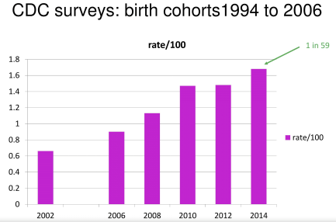In most countries, the prevalence of Autism Spectrum Disorders has risen sharply over the past few decades.
Within OECD countries, the prevalence appears to have increased sixfold over the past 40 years, now affecting approximately 1% of the population – though estimates vary significantly across countries and studies.
Part of this rise seems to stem from improved detection and changes in diagnostic definitions and criteria, particularly between DSM-IV and DSM-5 (DSM: Diagnostic and Statistical Manual of Mental Disorders).
Whether the increase is primarily due to better detection or a true underlying surge has long been debated within the scientific community and has led to numerous studies.
Today, the consensus suggests that roughly 20–25% of the apparent increase can be attributed to improved detection. However, the remaining 75–80% reflects a genuine and dramatic rise in autism over recent decades (Nevison, 2014).
Among the highest estimates is that of the U.S. Centers for Disease Control and Prevention (CDC), which in 2020 reported that, based on 2016 data, approximately 1 in 54 American children had been diagnosed with an autism spectrum disorder.
The prevalence of autism spectrum disorders appears to have increased sixfold over the past 40 years, now reaching approximately 1% of the population.
A valuable source among many scientific publications :
Nevison, C.D. A comparison of temporal trends in United States autism prevalence to trends in suspected environmental factors. Environ Health 13, 73 (2014)

For families
The rise in the prevalence of autism spectrum disorders is indeed a reality, even if it is still sometimes questioned or attributed to improved detection and related factors.
You are, therefore, at the heart of a profound societal shift and deserve the full support and engagement of everyone.
Despite some variation in methods and findings, a substantial body of epidemiological research confirms a significant rise in Autism Spectrum Disorders.
Moreover, the differences in prevalence between countries cannot be explained by methodological variations alone (Chiarotti et al., 2024), further supporting the hypothesis that environmental factors play a major role.






